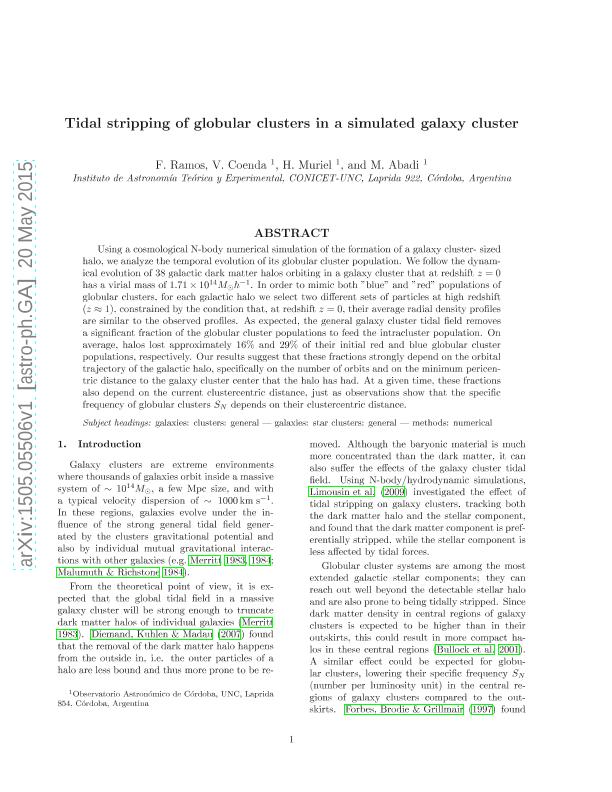Artículo
Tidal stripping of globular clusters in a simulated galaxy cluster
Fecha de publicación:
06/2015
Editorial:
IOP Publishing
Revista:
Astrophysical Journal
ISSN:
0004-637X
Idioma:
Inglés
Tipo de recurso:
Artículo publicado
Clasificación temática:
Resumen
Using a cosmological N-body numerical simulation of the formation of a galaxy-cluster-sized halo, we analyze the temporal evolution of its globular cluster population. We follow the dynamical evolution of 38 galactic dark matter halos orbiting in a galaxy cluster that at redshift z = 0 has a virial mass of 1.71 × 1014 Mȯ h-1. In order to mimic both "blue" and "red" populations of globular clusters, for each galactic halo we select two different sets of particles at high redshift (z ≈ 1), constrained by the condition that, at redshift z = 0, their average radial density profiles are similar to the observed profiles. As expected, the general galaxy cluster tidal field removes a significant fraction of the globular cluster populations to feed the intracluster population. On average, halos lost approximately 16% and 29% of their initial red and blue globular cluster populations, respectively. Our results suggest that these fractions strongly depend on the orbital trajectory of the galactic halo, specifically on the number of orbits and on the minimum pericentric distance to the galaxy cluster center that the halo has had. At a given time, these fractions also depend on the current clustercentric distance, just as observations show that the specific frequency of globular clusters SN depends on their clustercentric distance.
Archivos asociados
Licencia
Identificadores
Colecciones
Articulos(IATE)
Articulos de INST.DE ASTRONOMIA TEORICA Y EXPERIMENTAL
Articulos de INST.DE ASTRONOMIA TEORICA Y EXPERIMENTAL
Citación
Ramos Almendares, Felipe Alberto; Coenda, Valeria; Muriel, Hernan; Abadi, Mario Gabriel; Tidal stripping of globular clusters in a simulated galaxy cluster; IOP Publishing; Astrophysical Journal; 806; 2; 6-2015; 242-248
Compartir
Altmétricas




